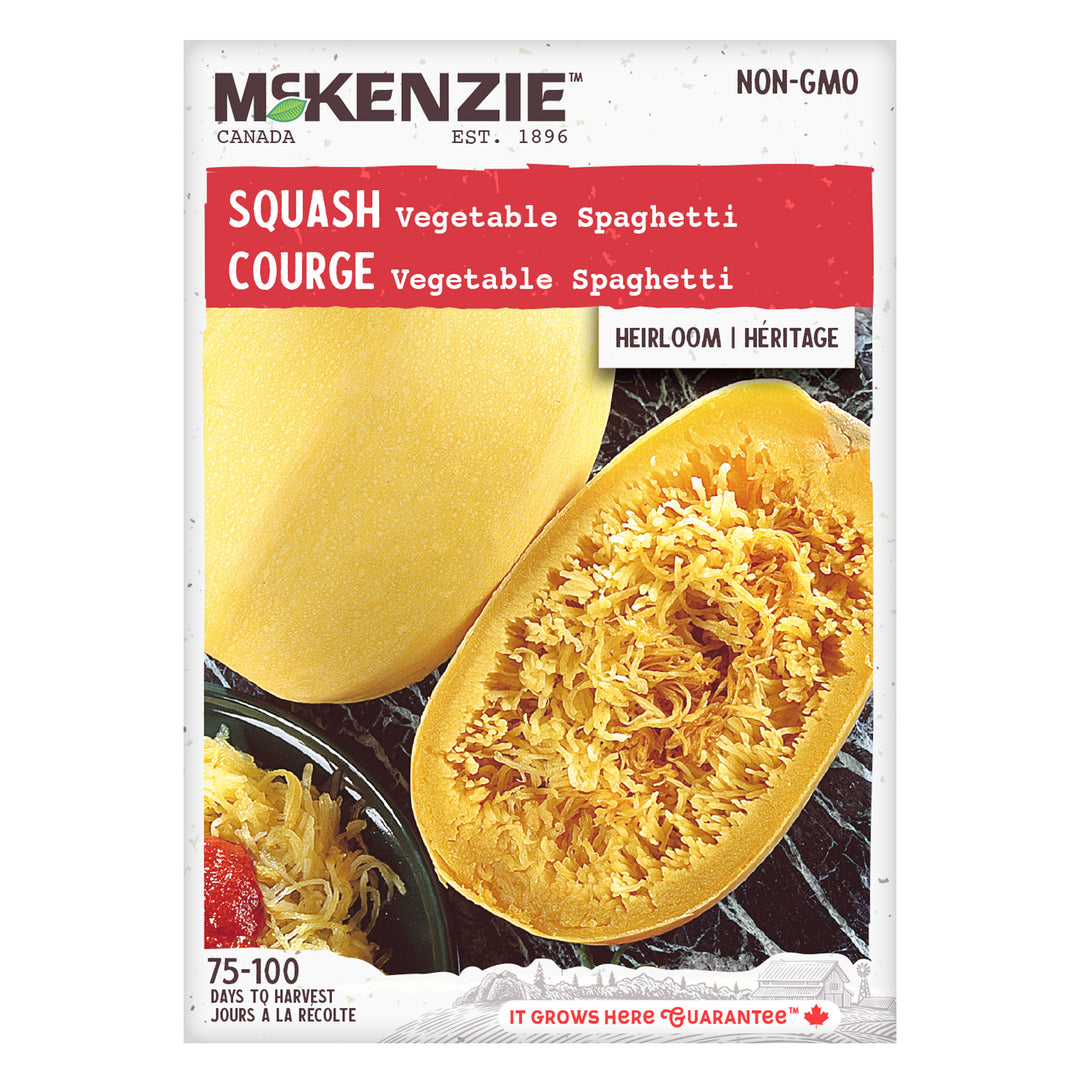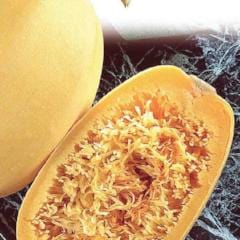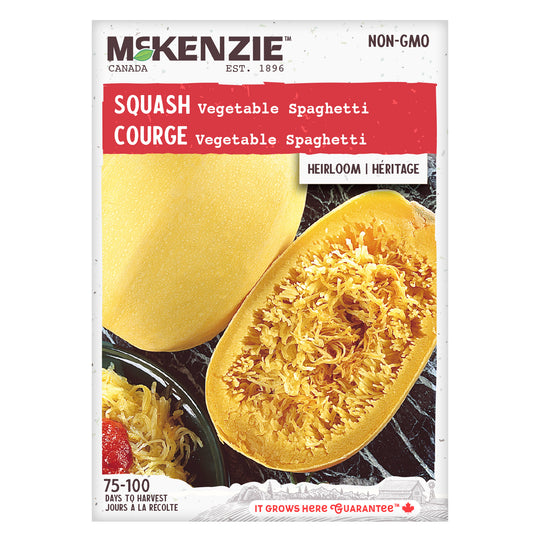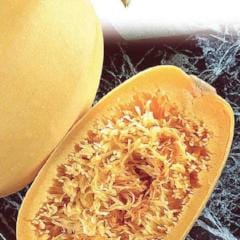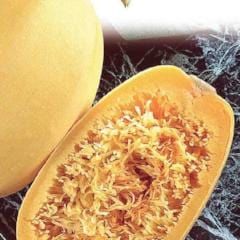Squash Vegetable Spaghetti - McKenzie Seeds
- Canada-Wide Shipping
- Flat Rate Shipping on Seeds
- Secure Payment & Checkout
- In stock, ready to ship
- Backordered, shipping soon
Cucurbita pepo
- Heirloom
- 75 to 100 days to harvest
- 5 to 12 days to maturity
-
Chewy with a mild flavor
Vegetable Spaghetti Pasta Squash are large and creamy yellow when mature. This winter squash grows cylindrical shaped fruit 25-30 cm (10-12") long and 18 cm (7") in diameter on trailing vines. Cut open the squash, remove the seeds, then scrape out the inside to discover the pasta-like strands.
3g. (approx. 15-20 Seeds)
Sow seed direct after last frost, or for an earlier crop, start indoors 3-4 weeks before last frost. Soil should b e rich and well-drained. Requires generous watering in dry weather.
Planting Depth: 2.5 cm (1")
Planting Spacing: 3 per hill
Row Spacing: 1.5-1.8 m (5-6')
Boil or bake the fruit until skin can be pierced with a fork before cutting open.
Preparation Ideas: Preheat over to 400 F. Carefully cut the squash in half lengthwise. Use a spoon to scrape out the seeds and stringy bits of flesh. You do not want to remove any of the flesh. Place squash halves upside down in a backing dish. Add a little water to just cover the bottom of the backing dish. Roast the squash for 30 to 45 minutes, depending on the size of the squash. Remove from oven and turn the halves to flesh side up. The squash is ready when it is easy to shred the flesh into spaghetti like strands with the tines of a fork. You can do a taste test and if the strands are more crunchy then you prefer, place back in the oven for a while longer. If you prefer long spaghetti-like strands, rake your fork in the same direction as the strands. If desired, toss strands with butter or olive oil and salt and pepper.
Planting Instructions: Sow directly into the garden once the danger of frost has passed or for an earlier crop, start indoors 3-4 weeks before the last frost using 3-4” Jiffy peat pots and make sure to weather/harden off the plants before setting them in the ground.
Best when planted in a rich, moist, well-drained soil in full sun. Transplants should only go into the garden once soil is completely warmed.
Sow seeds 2.5 cm (1″) deep and sow 5-6 seeds per hill or 5 cm (2″) apart. Plants should be spaced/thinned to approximately 3 plants per hill or 15 cm (6″) apart. Rows should be spaced 1.5-1.8 m (5-6′) apart.
Seeds germinate in approximately 5-12 days.
The size of your garden may determine which squash varieties to grow – squash plants require a large space. Smaller fruited varieties can be trained up a trellis which can help save space.
Keep soil adequately moist throughout the season and give plants a nice deep watering once a week. When watering, try to avoid wetting the plant’s leaves as this can encourage disease.
Spaghetti Squash – After cooking, this interesting squash can be pulled out in strands similar in appearance to spaghetti. Popular with kids!
Harvest and Storage
Summer squash tastes better when smaller in size so for best quality and flavor, they should be harvested when young and tender. Squash grow rapidly so it is a good idea to regularly (every 1 or 2 days) check for more, especially in hot weather.
Often summer squashes are harvested too late when the fruit is large and hard. Most elongated varieties are picked when they are 2-3 inches in diameter and 6 to 8 inches long.
Regular harvesting will increase the yield.
Use a sharp knife or pruning shears to harvest and wear gloves if possible as the leafstalks and stems are prickly and can scratch and irritate unprotected hands and arms
To store summer squash, harvest small squash and place, unwashed in plastic bags in the crisper drawer of the refrigerator. Wash the squash just before preparation. As with most vegetables, water droplets promote decay during storage. The storage life of summer squash is brief, so use within two to three days.
Winter squash can be usually be harvested when the vines have died or around the time of a light frost. The fruits will have turned a deep, solid color and the rind will be hard (not easily pierced by a fingernail). Harvest the main part of the crop before heavy frosts hit your area.
Cut squash from the vines carefully, leaving two inches of stem attached. Avoid cuts and bruises when handling. Fruits that are not fully mature, have been injured, have had their stems knocked off, or have been subjected to heavy frost do not keep and should be used as soon as possible or be composted.
Store on a shelf (not on cement floor) in a cool dry location around 10-13°C (50-55°F).
Companion planting: Corn, onion, radish
Eating Squash:
Summer squash can be grilled, steamed, boiled, sautéed, fried or used in stir fry recipes. They mix well with onions, tomatoes and okra in vegetable medleys. Summer squash can be used interchangeably in most recipes.
To cook winter squash, place unpeeled pieces cut sides down on a shallow baking dish and bake in a 350°F oven for 30 minutes or longer. Check for doneness by piercing with a fork or skewer. When tender, remove from the oven and allow the pieces to cool. Spoon out the soft flesh and mash with a fork or process in a blender or food processor. Small acorn squash and spaghetti squash can be pierced in several places with a long-tined fork or metal skewer and baked whole. Piercing prevents the shell from bursting during cooking. Place the squash on a baking dish and bake for 1 1/2 to 2 hours at 325°F.
Canada Shipping
All regular packaged seed* orders have a flat rate shipping fee starting at $6.85 for Letter Mail shipping and $14.85 for Expedited Shipping.
*Some Bonus Packs, Sprouting Seeds, Bulk packs, Sprinkle Bags, and Sprinkle Cans will only be available with Expedited Shipping due to larger packaging and weight.
US Shipping
US Shipping has been suspended indefinitely. We apologize for any inconvenience this may cause. We hope to serve our US customers again in the future.



